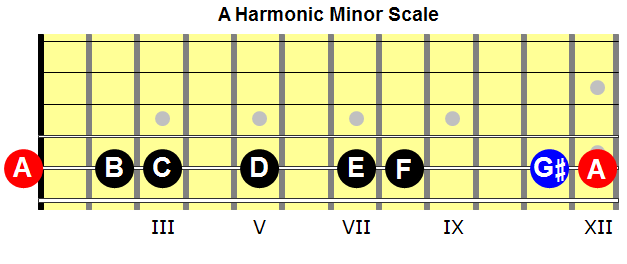Raising the seventh degree of a natural minor scale and, thus, creating a harmonic minor scale has two primary purposes:
- It creates a leading tone that pulls strongly to the tonic note a half step above it.
- It changes the minor v chord in the natural minor scale into a dominant seventh V7 chord in the harmonic minor scale, strengthening the authentic cadence.
This post will analyze the leading tone with regard to the harmonic minor scale and the authentic cadence. It will also provide instruction on how the leading tone relates to guitar soloing over minor key chord progressions.
The Leading Tone
Leading tone is the terminology associated with the seventh scale degree, located a half step below the tonic note.
Major Scale
A major scale contains a leading tone. There is a half step between the seventh scale degree and the tonic note.
For example, in a C major scale there is a half step between the seventh scale degree, B and the tonic note, C (fig.1).
Fig.1

Natural Minor Scale
A natural minor scale does not contain a leading tone. There is a whole step between the flatted seventh scale degree and the tonic note.
For example, in an A minor scale there is a whole step between the flatted seventh scale degree, G, and the tonic note, A (fig.2).
Fig.2

Harmonic Minor Scale
When we raise the seventh degree of a natural minor scale by a half step (and create a harmonic minor scale), we create a leading tone, a seventh scale degree located a half step below the tonic note.
For example, when we raise the flatted seventh scale degree of an A natural minor scale from G to G# (creating an A harmonic minor scale), we create a leading tone, a seventh scale degree located a half step below the tonic note, A (fig.3).
Fig.3

Natural Minor Scale vs. Harmonic Minor Scale
If you were to play an A natural minor scale followed by an A harmonic minor scale on a guitar, you should notice that the seventh degree in the harmonic minor scale resolves more strongly to the tonic note than does the flatted seventh degree in the natural minor scale.
This is because any given note pulls strongest to the note located a half step above or below it and next strongest to the note located a whole step above or below it.
The V Chord
The Minor Seventh (v7) Chord
In a harmonized natural minor scale the v chord is minor or minor seventh in quality.
For example, the v7 chord in a harmonized A minor scale is Em7, which contains the notes E, G, B and D — the first, flatted third, fifth and flatted seventh notes in an E major scale (fig.4).
Fig.4

The Dominant Seventh (V7) Chord
In a harmonized harmonic minor scale the V chord is major or dominant seventh in quality.
For example, the V7 chord in a harmonized A harmonic minor scale is E7, which contains the notes E, G#, B and D — the first, third, fifth and flatted seventh notes in an E major scale (fig.5).
Fig.5

Stronger Authentic Cadence
As detailed in the post entitled The Dominant Seventh Chord, the sound of the V7 chord in any given key moving to the tonic I or i chord a perfect fifth below it is called an authentic cadence.
The sound of a dominant seventh V7 chord moving to a tonic i chord creates a much stronger cadence (resolution) than a minor seventh v7 chord moving to the same tonic i chord.
For example, the sound of an E7 chord moving to an Am chord is stronger than the sound of an Em7 chord moving to an Am chord.
The reason is that a dominant seventh chord (E7) contains the leading tone in the scale or key (G#), which pulls strongly to the tonic note (A) a half step above it (fig.6a).
An Em7 chord contains a G natural, which doesn’t pull as strongly to the A a whole step above it (fig.6b).
Fig.6

Soloing Application
When the V7 chord appears in a minor key chord progression, you can use the harmonic minor scale of the i chord to solo over the progression.
For example, the progression in fig.7 is in the key of A minor and contains an E7 chord.
You can use an A harmonic minor scale to solo over the progression.
Fig.7

Related Posts
Related posts include:
